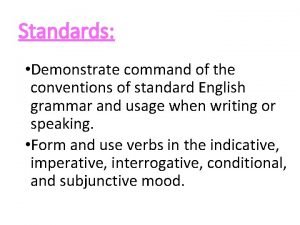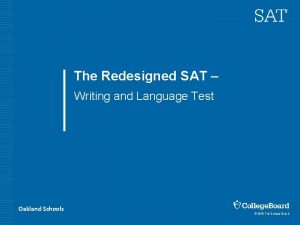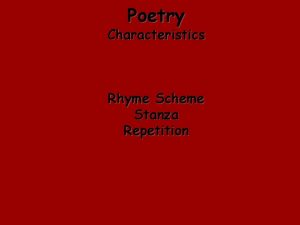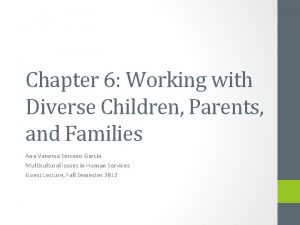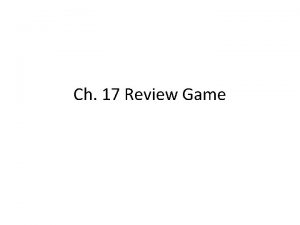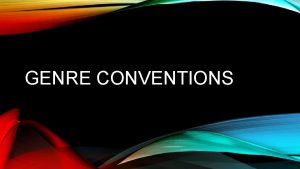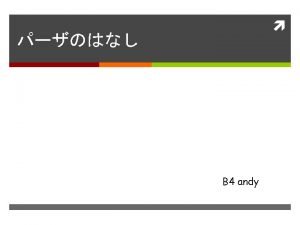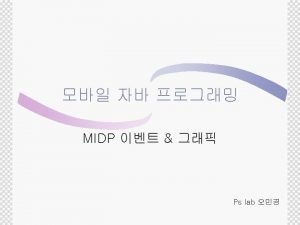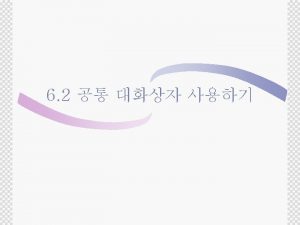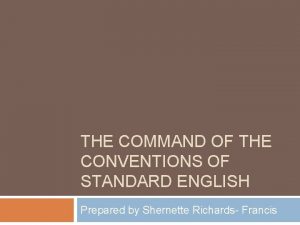Standards Demonstrate command of the conventions of standard









- Slides: 9

Standards: • Demonstrate command of the conventions of standard English grammar and usage when writing or speaking. • Form and use verbs in the indicative, imperative, interrogative, conditional, and subjunctive mood.

Essential Questions • What is verb mood? • How can I identify shifts in verb mood and voice?

Verb Mood • Mood is the attitude a verb conveys in a sentence. Changing the verb’s mood will change the tone of the sentence. Verb moods indicate a state of being or reality.

Indicative Mood • The indicative mood indicates a state of factuality and reality. • Ex: "A cat sits on the stove. " • Most sentences in English are in the indicative mood. • It simply states a fact of some sort, or describes what happens, or gives details about reality.

Imperative Mood • The imperative mood indicates a state of command. • Ex: "Give me back my money. " • One marker of the imperative is that frequently the subject does not appear in the sentence, but is only implied: "(You) Give me back my money. "

Interrogative Mood • The interrogative mood indicates a state of questioning. • Ex: "Will you leave me alone now? " • One marker of the interrogative is that frequently the speaker inverts or switches the subject-verb order by placing the helping verb first, before the subject: "Will you leave me alone? " instead of "You will leave me alone. " • Frequently the interrogative appears with requests for a course of action or requests for information.

Conditional Mood • The conditional mood indicates a conditional state that will cause something else to happen. • Ex: The bomb might explode. • The conditional is marked by the words might, may, could, and would. • Frequently, a phrase in the conditional appears closely linked to a phrase in the subjunctive preceded by a subordinate conjunction like if.

Subjunctive Mood • The subjunctive mood indicates a hypothetical state, a state contrary to reality, such as a wish, a desire, or an imaginary situation. • Ex: If you jiggle that switch, the bomb might explode. • Note that the 2 nd clause is conditional, the 1 st is subjunctive.

Mood Example Indicative She is happy. Imperative Smile! (Note: The subject “you” is implied rather than stated. ) Interrogative Is she happy? (Note: the subject follows the verb. ) Conditional She could be happy. Subjunctive If she won the lottery, she would be happy.
 Command of conventions definition
Command of conventions definition Standard english conventions sat practice
Standard english conventions sat practice Hard customer defined standards
Hard customer defined standards Standards rhyme
Standards rhyme Lessons learned from mount carmel contest
Lessons learned from mount carmel contest Edip method
Edip method Bicultural couples tend to demonstrate extremes in
Bicultural couples tend to demonstrate extremes in Which feature does this image demonstrate?
Which feature does this image demonstrate? Demonstrate knowledge and understanding
Demonstrate knowledge and understanding Miller and urey's experiments attempted to demonstrate
Miller and urey's experiments attempted to demonstrate
